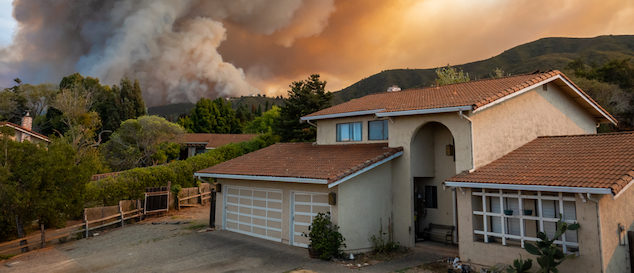News
California, battered by 2020, girds for more intense wildfires
 A wildfire burns near a home in Salinas, Monterey County, last year. (Photo: David A Litman)
A wildfire burns near a home in Salinas, Monterey County, last year. (Photo: David A Litman)With 2020’s disasters in mind, the state is making elaborate plans to deal with an upcoming wildfire season made potentially more deadly by drought.
The challenge is there, and it’s a big one.
Last year’s 9,639 wildfires blackened 4,397,809 acres, making 2020 the most ferocious wildfire season in California’s modern history, according to the state Department of Forestry and Fire Protection. The August Complex fire –a”gigafire” — burned over 1 million acres across seven counties, an area larger than the state of Rhode Island. More than 10,000 structures were destroyed at a cost of more than $12 billion.
So far this year, California already is experiencing a 26% increase in wildfire activity over last year and a 58% increase in acres burned compared to 2020, state officials reported. As temperatures continue to rise increase and the drought intensifies, the expectation is that wild fire dangers will increase still further.
“The fact that it is drier is overall the worst case scenario,” Heath Hockenberry, the fire weather program manager for the National Weather Service, told the LA Times. “I don’t want to characterize this season as the worst case scenario but the worst case scenario is when you have long-term drying, no rain and you throw lightning on top of that.”
The feared wildfires also affect home prices in a state where those costs already are high. There are proposals, endorsed by the state’s insurance regulator, to limit construction in fire-prone areas. Such a limit could eventually affect home values.
“It all comes down to an inescapable fact: Those who lost their homes still need places to live. Areas like Napa and Sonoma Counties were already experiencing housing shortages, exacerbated by fires from previous years and pandemic buyers,” Realtor.com reported in October 2020.
But over the long haul, prices may plummet, as residents — tired of the incessant threat, evacuations and close calls of wildfires — head elsewhere to live.
Gov. Gavin Newsom’s proposal, dubbed the Wildfire and Forest Resilience Action Plan,” calls for more fuel breaks to help eliminate threats near inhabited areas, improved satellite detection of potentially dangerous areas and improved coordination of firefighting efforts between the state, local government and the federal government.
The plan amounts to a monumental bureaucratic partnership, fusing together efforts from a number of state agencies, along with local and federal governments, all aiming at dealing with the wildfire challenge.
Although billed as a new invention, the plan cites actions in the 2018-2019 and 2019-2020 state budgets, including:
–Hiring of 858 new seasonal CALFIRE firefighters in 2020.
–An increase in the CalFire air force with the addition of with $127.2 million in new aircraft, including C-130H air tankers and 12 Black Hawk helicopters capable of nighttime firefighting operations.
–A proposed allotment of $1 billion in Newsom’s proposed 2021-2022 budget, to include $323 million to protect communities, reduce risk of large, catastrophic wildfires and boost economic recovery in rural communities.
–Spending $67.5 million to buy 13 additional fully staffed year-round fire engines, in addition to heavy fire equipment operators.
–Acquiring and placing state-of-the-art wildfire technology into the hands of incident commanders. It can project the direction, size and distance a wildfire may travel based on real-time weather, terrain and fuels conditions.
–Partnering with the federal government on a satellite-based wildfire detection system
–Starting the California National Guard on infrared-equipped drones to support firefighting missions.
–Funding for an additional 100 infrared fire monitoring cameras on remote communications towers to help dispatchers and firefighters identify and confirm wildfires’ locations.
–Securing $25 million annually to fund city and county firefighting engines and crews so they can pre-deploy in strategic locations and respond to breaking fires.
The plan amounts to a monumental bureaucratic partnership, fusing together efforts from a number of state agencies, along with local and federal governments, all aiming at dealing with the wildfire challenge.
The need is there, says Secretary for Natural Resources Wade Crowfoot. “Catastrophic wildfires represent a severe and worsening threat that requires bold action … we need to shift our paradigm and invest in a scaled-up, cohesive strategy built on science to restore landscapes and protect communities,” he declared in a written statement.
The state’s looming wildfire situation may even have a statewide effect on home prices. There are proposals, endorsed by the state’s insurance regulator, to limit construction in fire-prone areas. Such a limit could eventually affect home values.
The plan has won praise from environmental groups.
The proposal is “absolutely critical to reducing the risk that severe wildfires pose to our communities, air quality, wildlife and water supplies,” said Jay Ziegler of The Nature Conservancy.
Want to see more stories like this? Sign up for The Roundup, the free daily newsletter about California politics from the editors of Capitol Weekly. Stay up to date on the news you need to know.
Sign up below, then look for a confirmation email in your inbox.

Leave a Reply